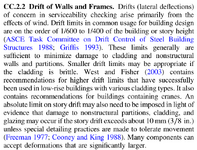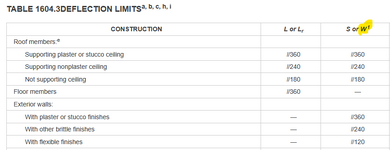Greenalleycat
Structural
- Jul 12, 2021
- 617
This topic coming at you from some office musings
In the residential world it's pretty common to get lovely things such as a house on the side of a hill facing an ocean
These sites get the lovely combo of both higher wind loads due to the ocean/terrain combined with regular/reliable winds i.e. a higher frequency of windy days than inland sites
These types of houses also inevtiably have lovely architectural features such as 4m cantilever floating roofs (definitely not basing this on a real job...)
For such features, the cantilever tip deflection is a critical consideration - the client doesn't want to see a permanent sag, and they don't want to sit inside and watch it flop around in a wind
So we design to a serviceability condition that is based on a 1/25 year wind - say L/150 or L/300 maybe
For our 4m cantilever that still equates to a tip deflection of 15-25mm which I think would be a bit displeasing to watch - but hey, it's only 1/25 years, right?
Enter the 1/1 year wind - under our code, the 1/1 wind is 63% of the loading of the 1/25 year wind
So you'll be getting ~10-20mm of tip deflection occurring once a year (and you can keep reducing that fraction for more frequent winds again)
To me, even 10mm of deflection occuring ever year feels like it could be enough to get a displeased owner ringing you up for an explanation - they do say it's serviceability issues get you sued, not ultimate issues, after all...
Is a 1/25 year wind actually the right metric to be considering? Maybe, as I'm not aware of issues in reality?
In the residential world it's pretty common to get lovely things such as a house on the side of a hill facing an ocean
These sites get the lovely combo of both higher wind loads due to the ocean/terrain combined with regular/reliable winds i.e. a higher frequency of windy days than inland sites
These types of houses also inevtiably have lovely architectural features such as 4m cantilever floating roofs (definitely not basing this on a real job...)
For such features, the cantilever tip deflection is a critical consideration - the client doesn't want to see a permanent sag, and they don't want to sit inside and watch it flop around in a wind
So we design to a serviceability condition that is based on a 1/25 year wind - say L/150 or L/300 maybe
For our 4m cantilever that still equates to a tip deflection of 15-25mm which I think would be a bit displeasing to watch - but hey, it's only 1/25 years, right?
Enter the 1/1 year wind - under our code, the 1/1 wind is 63% of the loading of the 1/25 year wind
So you'll be getting ~10-20mm of tip deflection occurring once a year (and you can keep reducing that fraction for more frequent winds again)
To me, even 10mm of deflection occuring ever year feels like it could be enough to get a displeased owner ringing you up for an explanation - they do say it's serviceability issues get you sued, not ultimate issues, after all...
Is a 1/25 year wind actually the right metric to be considering? Maybe, as I'm not aware of issues in reality?



